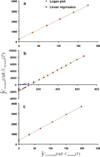Impact of isoflurane anesthesia on D2 receptor occupancy by [18F]fallypride measured by microPET with a modified Logan plot
- PMID: 21584868
- PMCID: PMC4078917
- DOI: 10.1002/syn.20955
Impact of isoflurane anesthesia on D2 receptor occupancy by [18F]fallypride measured by microPET with a modified Logan plot
Abstract
In the previous work, we reported a method that utilized imaging data collected from 60 to 120 min following [(18) F]fallypride administration to estimate the distribution volume ratio DVR' (DVR' ∝ DVR; DVR = 1 + BP(ND) , where BP(ND) is a measure of receptor density, DA D2 in this case). In this work, we use this method to assess the effects of isoflurane anesthesia on [(18) F]fallypride DVR'.
Methods: Rats were injected with [(18) F]fallypride either unconsciously under ∼1.5% isoflurane via the tail vein (Group 1) or consciously via a catheter inserted either in the jugular vein (Group 2) or the tail vein (Group 3). After about 1 h of free access to food and water the rats were anesthetized with 1.5% isoflurane and imaged in a microPET for 60 min. The rats that were injected consciously (Groups 2 and 3) were placed in a rat restrainer during [(18) F]fallypride injection. They were habituated in that restrainer for 3 days prior to the experiment day to minimize restraint-related stress. For comparison, a control group of rats was imaged for 120 min simultaneously with the administration of [(18) F]fallypride i.v. while under 1.5% isoflurane. The DVR' estimates from the 60 min acquisitions were compared with the DVR' from the last 60 min of the 120 min acquisitions (after neglecting the first 60 min). In addition, the striatal time-activity curves were fit with a 2-tissue + plasma compartment model using an arbitrary simulated plasma input function to obtain k(3) /k(4) (≈ BP(ND) ) for the 60 and 120 min acquisitions.
Results: Isoflurane anesthesia caused a significant reduction, up to 22%, in the DVR' estimates, which were 15.7 ± 0.3 (mean ± SE) for the controls, 17.7 ± 0.3 for Group 1, 19.2 ± 0.4 for Group 2, and 18.8 ± 0.7 for Group 3. The compartmental model fit produced similar results, ∼30% reduction in k(3) /k(4) for the 120-min acquisitions compared with the 60-min acquisitions (initial conscious uptake of the radiotracer).
Conclusion: The results of this study demonstrate that isoflurane anesthesia significantly decreases striatal [(18) F]fallypride BP(ND) in rats. Of similar importance, this work demonstrates the effectiveness of delayed scans following radiotracer injection and the implication that different types of studies can be conducted simultaneously with this method, including studies of behavioral and environmental impact on brain receptors.
Copyright © 2011 Wiley-Liss, Inc.
Figures



References
-
- Abercrombie ED, Keefe KA, DiFrischia DS, Zigmond MJ. Differential effect of stress on in vivo dopamine release in striatum. Nucleus accumbens, and medial frontal cortex. J Neurochem. 1989;52:1655–1658. - PubMed
-
- Adachi YU, Yamada S, Satomoto M, Higuchi H, Watanabe K, Kazama T. Isoflurane anesthesia induces biphasic effect on dopamine release in the rat striatum. Brain Res Bull. 2005;67:176–181. - PubMed
-
- Ansari MS, Kessler RM, Clanton JA, de Paulis T, Baldwin RM. Comparison of three [18F]fallypride methods intended for automated remote chemistry modules. J Nucl Med. 2006;47:159P.
-
- Antelman SE, Szechtman H, Chin P, Fisher AE. Tail pinch-induced eating, gnawing and licking behaviour in rats: Dependence on the nigrostriatal dopamine system. Brain Res. 1975;99:319–337. - PubMed
-
- Cavazzuti M, Porro CA, Biral GP, Benassi C, Barbieri GC. Ketamine effects on local cerebral blood-flow and metabolism in the rat. J Cereb Blood Flow Metab. 1987;7:806–811. - PubMed
Publication types
MeSH terms
Substances
Grants and funding
LinkOut - more resources
Full Text Sources
